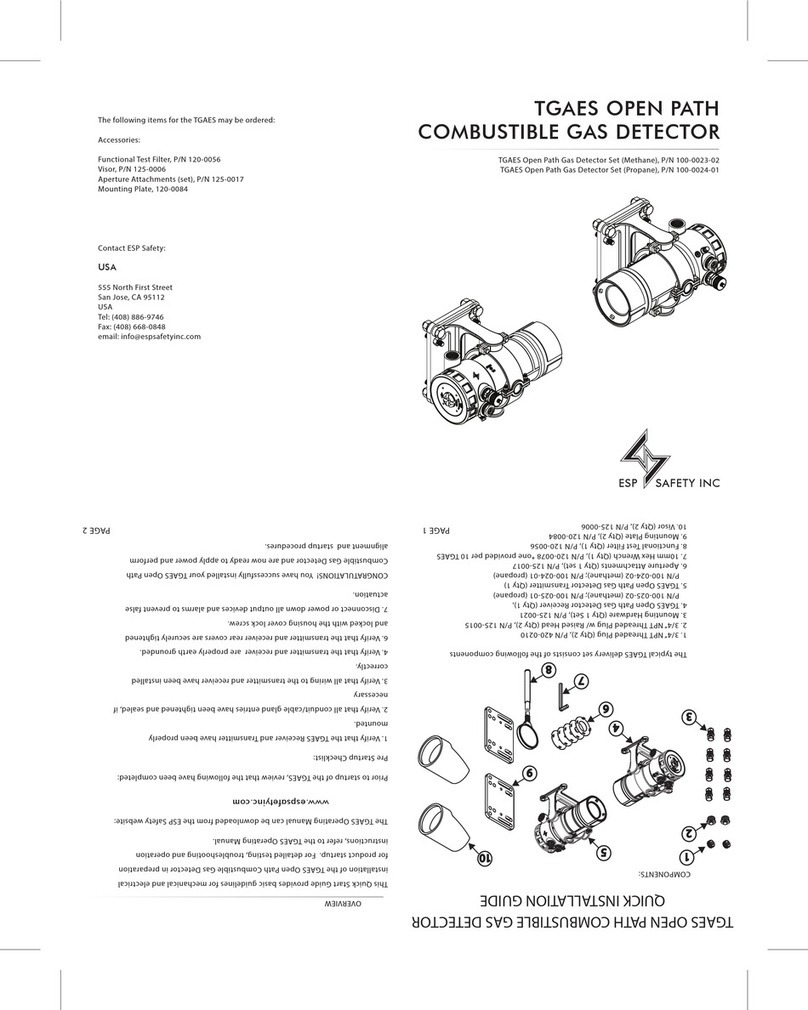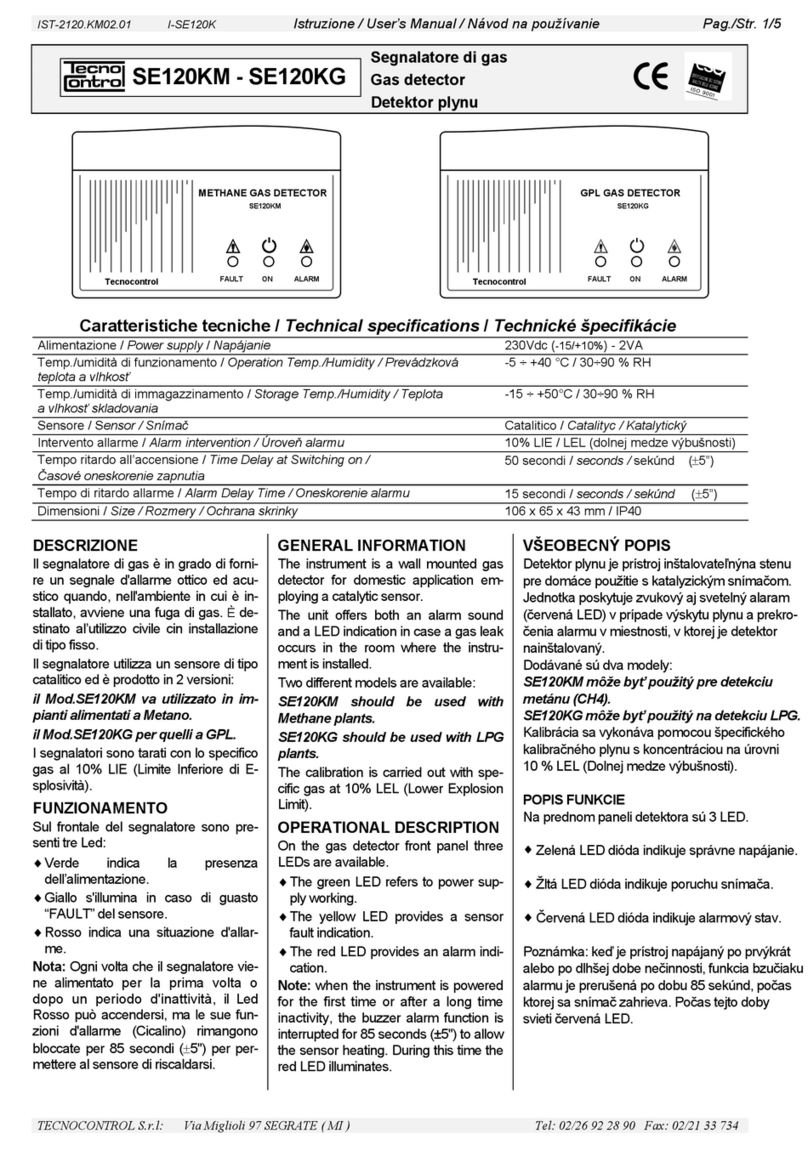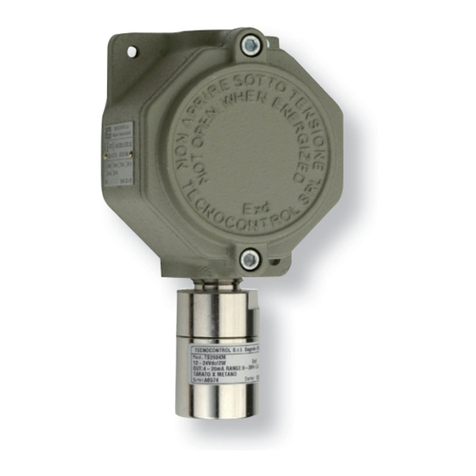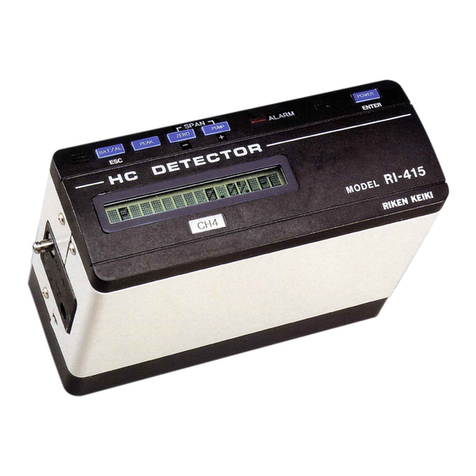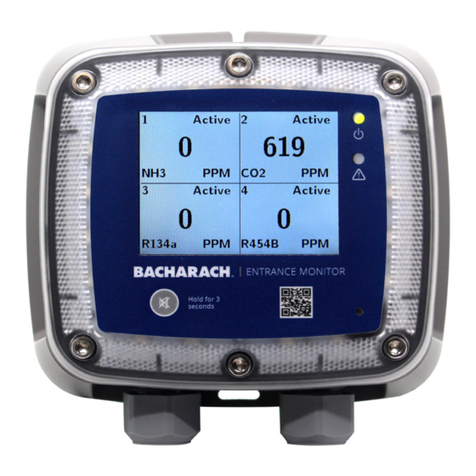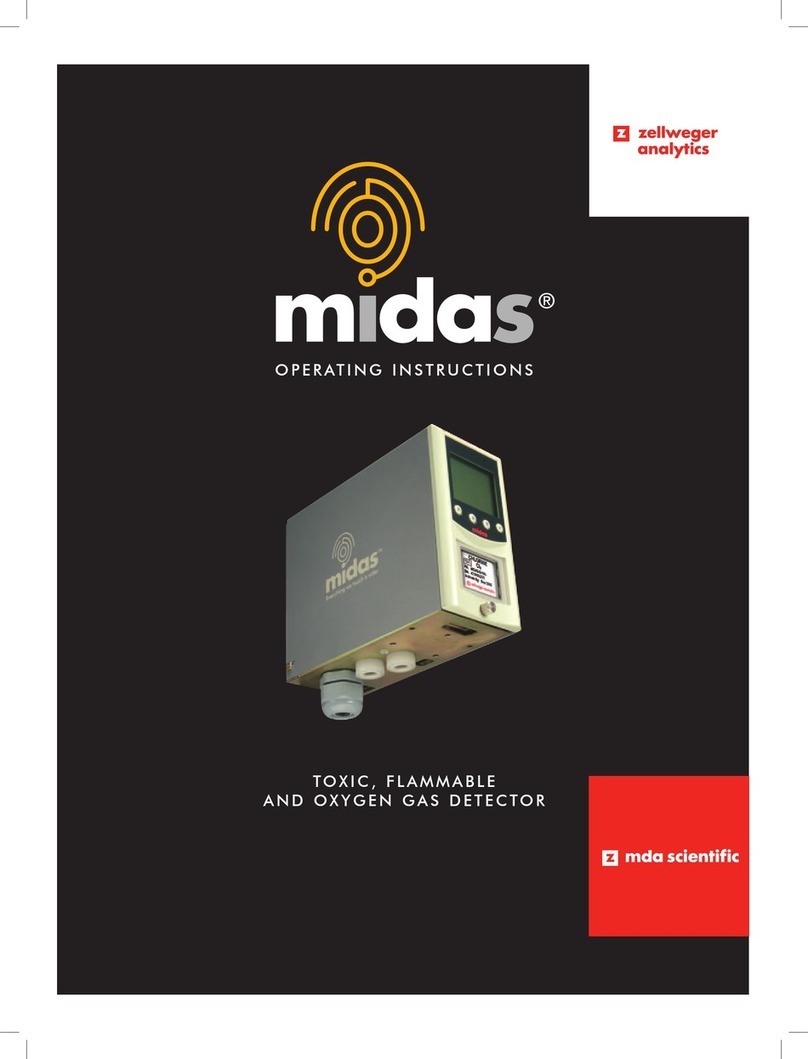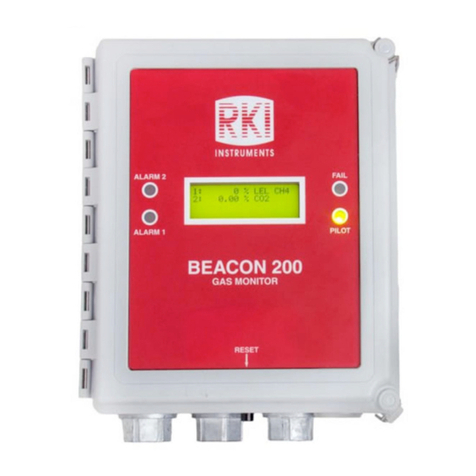ESP Safety SGOES User manual

SGOES Infrared Hydrocarbon Gas Detector
Operating Manual
820-0006

SGOES Infrared Hydrocarbon Gas Detector
Operating Manual
820-0006
ESP Safety, Inc.
555 North First Street
San Jose, CA 95112 USA
408-886-9746
Revision History: 820-0006
Date
Revision
Description
Approved
03/20/14
4.5
Reformat
03/24/14
5
Update for clarity
10/08/18
6
Terminal Labels

SGOES Infrared Combustible Gas Detector
820-0006 Operating Manual
Page ii
Revised 3/20/2014
Table of Contents
1.0 Introduction ...................................................................................................................................................................... 4
Product Overview ..................................................................................................................................................................... 4
ESP Safety Inc Contact Information .......................................................................................................................................... 4
Principles of Operation ............................................................................................................................................................. 5
SGOES Components.................................................................................................................................................................. 6
SGOES Dimensional Drawing .................................................................................................................................................... 6
2.0 Specifications & Technical Data ......................................................................................................................................... 7
Ordering Guide ......................................................................................................................................................................... 8
Certifications and Compliance .................................................................................................................................................. 9
Protective Weather Cover ...................................................................................................................................................... 10
Internal Optics Heater............................................................................................................................................................. 10
3.0 Safety Considerations.......................................................................................................................................................10
Guidelines ............................................................................................................................................................................... 10
Explosion Protection Means ................................................................................................................................................... 10
4.0 Installation .......................................................................................................................................................................11
Component Parts & Delivery Set ............................................................................................................................................ 11
Visual Examination.................................................................................................................................................................. 11
Guidelines for Locating the SGOES ......................................................................................................................................... 11
Mounting ................................................................................................................................................................................ 12
Earth Grounding...................................................................................................................................................................... 13
General Wiring Requirements ................................................................................................................................................ 14
SGOES Wiring Terminal Labels................................................................................................................................................ 14
Power Up and Stand Alone Operation of SGOES .................................................................................................................... 16
5.0 Calibration Procedures .....................................................................................................................................................17
SGOES Calibration Using ESP Commander.............................................................................................................................. 17
SGOES Calibration Using a HART Communicator.................................................................................................................... 19
SGOES Calibration Using Magnetic Wand............................................................................................................................... 20
6.0 Troubleshooting ...............................................................................................................................................................22
Troubleshooting Table ............................................................................................................................................................ 22
7.0 Maintenance ....................................................................................................................................................................23
Periodic Maintenance............................................................................................................................................................. 23
Maintenance Activities ........................................................................................................................................................... 23
8.0 Warranties .......................................................................................................................................................................24
9.0 Repair and Return.............................................................................................................................................................25
Field Repair ............................................................................................................................................................................. 25
Return Material Authorization (RMA) Number....................................................................................................................... 25
10.0 Parts Ordering Information.............................................................................................................................................26

SGOES Infrared Combustible Gas Detector
820-0006 Operating Manual
Page iii
Revised 3/20/2014
Appendix 1: Calculating Values...............................................................................................................................................27
Appendix 2: Gas Measurement Range....................................................................................................................................28
Appendix 3: Gas Flash Point Temperatures.............................................................................................................................29
Appendix 4: SGOES Terminal Block & Wiring for 3-wire and 4-wire Systems...........................................................................30
Appendix 5: Maximum Cable Lengths for Analog Connection (using 24VDC Supply) ...............................................................31
Appendix 6: HART Menu Tree.................................................................................................................................................32
Appendix 7: SGOES to Vector FCU ..........................................................................................................................................33
Appendix 8: SGOES to UPES....................................................................................................................................................34
Appendix 9: SGOES to Analog Input Module...........................................................................................................................35
It is important that this entire manual be thoroughly read and
understood prior to installing or operating the SGOES. Any
deviation from this manual may impair system performance and
compromise safety.

SGOES Infrared Combustible Gas Detector
820-0006 Operating Manual
Page 4
1.0 Introduction
Product Overview
The SGOES is a combustible gas detector that measures the concentration of
hydrocarbon gases present in the monitored environment. The SGOES is configured to
report alarms when the gas concentrations in the environment reach two independently
programmable levels, expressed as a percentage of the lower explosive limit (LEL) in air.
As determined by application requirements, the SGOES is factory calibrated with one of
eight hydrocarbon-based gases (typically methane or propane). Conversion factors are
used to correct for gases other than the factory calibration gas.
Moreover, SGOES is not sensitive to inadvertent detection of gases, such as nitrogen,
oxygen, carbonic acid, ammonia, and hydrogen sulfide. This makes the SGOES an
excellent choice for environments where non-hydrocarbon gases are present and precise
monitoring of combustible hydrocarbons like methane and propane is required.
Key Features
•Fast response time (T90 ≤ 5sec @ 100% LEL methane)
•Broadest operating temperature of detectors in its class (-60⁰C to 125⁰C / -
76⁰F to 257⁰F w optional Extended Temperature package)
•No significant zero drift
•High-performance weather protective cover eliminates water ingress of the
gas detection chamber, a common cause of false alarms with most IR detectors
•Simple, non-intrusive zero and span calibration
•Can be used in conjunction with ESPs SSS-903 or VECTOR Field Control Units to
provide local display of gas readings, alarm levels and device status.
ESP Safety, Inc. Contact
Information
Contact ESP Safety for application assistance or order placement.
ESP Safety, Inc.
555 North First Street
San Jose, CA 95112
USA
Telephone: 408-886-9746
FAX: 408-886-9757
website: www.espsafetyinc.com
Our Mission
ESP Safety, Inc.’s mission is to provide complete turn-key protection solutions beginning
with the design stage, through system installation and commissioning, and on-going field
service in hazardous environments. Our line of industry-leading products, services, and
systems benefits society, saves lives, and preserves capital resources.

SGOES Infrared Combustible Gas Detector
820-0006 Operating Manual
Page 5
Principles of Operation
Operation is based on selective signal disruption by hydrocarbon molecules. An infrared
light source is reflected to a set of optical detectors that simultaneously monitors the
infrared power at multiple wavelengths of the infrared spectrum. If no gas is present, the
photodetectors will receive all of the power radiated by the IR source. When gas
molecules enter the collection chamber the gas selectively absorbs infrared energy at
wavelengths specific to the gas. As a result the detector monitoring the wavelength
specific to the gas records a drop in infrared signal, and the signal from the detector
monitoring a wavelength unaffected by the gas does not change. The ratio of the
photodetector signals, when properly calibrated, provides a quantitative measurement
of the target gas concentration.
Figure 1-1: Hydrocarbon Gas Detection

SGOES Infrared Combustible Gas Detector
820-0006 Operating Manual
Page 6
SGOES Components
A. Explosion proof housing
B. Conduit entry for Field Wiring (3/4” NPT), x2
C. Tri-color LED Status Indicator
D. HART communication port (3/4” NPT), x1
E. Gas detection chamber
F. Integral mounting lugs
G. Magnetic Calibration Point
Figure 1-2: SGOES Components
A
B
C
F
D
G
E
Figure 1-3: SGOES Dimensions

SGOES Infrared Combustible Gas Detector
820-0006 Operating Manual
Page 7
2.0 Specifications and Technical Data
Mechanical Characteristics
Material
Stainless Steel (Type 316)
Conduit Connection
¾” NPT
2 connections for Field Wiring
1 connection for HART/USB
Dimensions
8.01” x 5.30” x 5.12”(203.5mm x 134.50mm x 130mm)
Weight (no sensors)
14.33lb (6.5 kg)
Optics Protection
Weatherproof Cover
Electrical Characteristics
Input Voltage
+24VDC Nominal (+18 to 32VDC)
Power Consumption
7.9W Maximum
Output From SGOES
+4-20mA industry standard analog with embedded HART
Digital RS-485 MODBUS RTU
HART interface with easy access dedicated connector
3 “Dry Contact” relays. Fault relay (NC/Form-B), alarm level 1 (NO/Form-A), alarm level 2
(NO/Form-A).
All Relays Contact Rating 1Amp@125VAC/30VDC
Alarm Relays
2 User Programmed Alarm Relays (factory default setting: NO)
1 Fault Condition Programmed Relay (factory default setting: NC)
Operational Characteristics
Gases detected
Methane, Propane, Butane, Pentane, Hexane,
Isobutane, Cyclopentane, Ethanol.
(The target gas is factory configured according to customer request.)
Gas Detection Range
0-100% LEL
Accuracy
± 2% of the full-scale gas concentration
Response Time
(for 100% LEL methane)
50% full scale < 1.9 seconds
90% full scale < 5.0 seconds
Humidity Range
Up to 95% RH, non-condensing
(Withstands up to 100% RH for short periods)
Warm-up time
10 minutes
Operating Temperature
-40oF to + 167oF (-40oC to +75oC), Extended Range -76oF to + 257oF (-60oC to +125oC)
Ingress Protection
IP66
RFI/EMI Protection
EN50081-1 / Class B E> 50270
*Operates with no interference from a 5 watt walkie-talkie keyed (transmitting) at 1 meter
Status Indication
Tri-color status LED indicates operational mode, fault, and gas presence.
Displayed information when
used w/ Field Control Unit
(SSS-903 or Vector)
Continuous sensor data
Gas Type
Measuring Units
Three Fixed Alarm Thresholds
Graphic display of trending data for Peak Readings and Time-Weighted Average (TWA) of
gas concentration 3-30 minutes

SGOES Infrared Combustible Gas Detector
820-0006 Operating Manual
Page 8
Ordering Guide
For simplicity of ordering, the SGOES is factory configured for detection specific gases. For gases not included in the
table below, please contact ESP Safety.
Scale Range
SGOES Model to
Order
Detected
Hydrocarbon
%LEL
%vol IEC6007920-
2000/BSEN617791:200
0
%vol ISO 10156
100-0001-M11-C1
Methane
0 to 100
0 to 4.4
0 to 5.0
100-0001-M11-C2
Propane
0 to 100
0 to 1.7
0 to 2.1
100-0001-05
Butane
0 to 50
0 to 0.7
0 to 0.9
100-0001-07
Isobutane
0 to 50
0 to 0.65
0 to 0.9
100-0001-09
Pentane
0 to 50
0 to 0.7
0 to 0.75
100-0001-11
Cyclopentane
0 to 50
0 to 0.7
0 to 0.75
100-0001-13
Hexane
0 to 50
0 to 0.5
0 to 0.55
100-0001-15
Propylene/Propene
0 to 50
0 to 0.1
0 to 1.5
100-0001-17
Methanol Vapor
0 to 50
0 to 2.75
0 to 3.65
100-0001-19
Ethanol Vapor
0 to 25
0 to 50
0 to 0.78
0 to 1.55
0 to 1.08
0 to 2.15

SGOES Infrared Combustible Gas Detector
820-0006 Operating Manual
Page 9
Certifications and Compliance
Explosion-proof for Class 1, Div.1, Group B, C, D (T4) Hazardous (classified) locations per FM 3615,
6310
Dust ignition-proof for Class II, Div.1, Group E, F, G Hazardous (classified) locations per FM 3615,
6310
Non-incendiary for Class 1, Div.2, Group A, B, C, D (T4), Class 2, Div.2, Group E, F, G (T4) Hazardous
(classified) locations per FM 3611
Performance verified up to 100% LEL methane-in-air atmosphere per FM 6320
Explosion-proof for Class 1, Div.1, Group B, C, D (T4) Hazardous (classified) locations per CSA C
22.2 # 30 and Ex d IIC T4 per CSA E 60079-0-1
Dust ignition-proof for Class II, Div.1, Group E, F, G Hazardous (classified) locations per CSA C 22.2
# 25
Non-incendiary for Class 1, Div.2, Group A, B, C, D (T4), Class 2, Div.2, Group E, F, G (T4) Hazardous
(classified) locations per CSA C 22.2 # 213
Performance verified up to 100% LEL methane-in-air atmosphere per CSA C 22.2 # 152
CE 0539 II 2 G
Ex d[ia] IIC T4 (Tamb 75°C)
IP 66
Ex d [ia] IIC T4
(Tamb 75°C)
IP 66
1 Ex d [ia] IIC T4 X T= -60°C....75°C
IP 66
EN Standards
EN 60079-0: 2006
EN 60079-1: 2007
EN 61779-1: 2000
EN 60529: 1991+A1: 2000
EN 50270: 2006.

SGOES Infrared Combustible Gas Detector
820-0006 Operating Manual
Page 10
Protective Weather
Cover
The protective weather cover is UV resistant, static-dissipating black plastic. It is
designed with internal baffles and hydrophobic filters to eliminate water ingress into the
detection chamber without limiting the flow of gases and vapors.
A separate calibration cup is supplied for use during zero and span calibration of the
SGOES.
Internal Optics Heater
The SGOES is designed with a heating system that eliminates moisture, condensation
and frost from the detector lens.
3.0 Safety Considerations
Guidelines
Before installing and operating the SGOES, be sure to read this entire
manual. Failure to follow these guidelines could result in impaired
product performance and safety hazards.
For maximum safety:
•SGOES wiring should comply with all governing electrical codes, standards and
regulations.
•Never operate the SGOES if the casing is damaged.
•Do not open the SGOES case when the unit is energized.
•Perform regular testing and maintenance as outlined in the Maintenance section.
•Ensure that alarm notification and control systems associated with the SGOES and its
detectors are switched off before any testing or maintenance to avoid unwanted
operation of alarms and control equipment.
Also see the individual sections in this manual for relevant specific safety guidelines.
Explosion Protection
Means
The SGOES is designed to be explosion-proof. Any user modifications to the device will
invalidate the explosion proof / flame proof certifications. All labeling must be intact and
visible. All Surfaces that are subject to disassembly or removal during installation or
maintenance must be installed as detailed in Appendix I and comply with the relevant NEC,
IEC and/or ATEX standards when replaced.
Hazardous location safety is ensured by:
•Cabling entering into and out of the SGOES must utilize connections certified for the
hazardous location where the SGOES unit is installed. The cable gland should be able to
withstand the pressure of an explosion and prevent the spread of combustion into the
hazardous area. The connection points are marked in the drawings with word “Explosion”
and indicate permissible values. Limit the ambient temperature to no higher than 85 °C.
•Use only with combustible gases with auto-ignition temperatures of 135 °C or higher.
•All the bolts securing the parts and enclosure must be sufficiently tightened and prevented
from loosening by using spring washers or lock nuts.

SGOES Infrared Combustible Gas Detector
820-0006 Operating Manual
Page 11
4.0 Installation
Component Parts and
Delivery Set
The SGOES parts and delivery set consists of the following:
•One SGOES infrared combustible gas detector
•One Protective Weather Cover
•One SGOES Operating Manual
•Accessory Kit (bolts, nuts, washers, etc.).
•Calibration Magnet (magnetic wand), P/N 611-0005
Compare the contents of the set to the packing list to be sure all items were received. If any
items are missing, contact ESP Safety Inc.
Visual Examination
Before installing the SGOES, examine the unit to ensure that:
•The nameplates and warning labels are in place.
•The external surfaces and joined surfaces of the SGOES casing are free of dents or
damage.
•Make sure all removable parts are joined to the casing as tightly as possible.
Guidelines for
locating the SGOES
There are no standard rules for selection and placement of sensors since the optimum
sensor choice location is unique for each application. Before installing the SGOES, check
the conditions at the installation site to make a placement determination.
The following guidelines can assist in determining the best possible placement of the
SGOES:
•Locate the SGOES detectors near potential gas leak sources and away from
excessive heat, light, wind, dust, water, vibration, shock, and radio frequency
interference (RFI).
•Ensure the installation location has sufficient space to accommodate the
SGOES housing and all necessary cabling.
•Mount the SGOES detector pointing horizontally
Preparing For Installation
•Before installation, evaluate the gas leak locations and other conditions such as
wind or air currents at the test site and configure the unit for that particular need.
Also, be sure to consult local installation codes.
Selection of gas sensor location is critical to the overall performance of the SGOES. Five
factors play an important role in the selection of sensor locations:
•Density of the gas to be detected
•Most probable leak sources within the industrial process
•Ventilation and prevailing wind conditions
•Personnel exposure
•Maintenance access

SGOES Infrared Combustible Gas Detector
820-0006 Operating Manual
Page 12
Density of Detected
Gas
If the target gas is heavier than air, the sensor should be located within 4 feet of grade.
Heavier than air gases will tend to settle in low-lying areas. For gases lighter than air, sensor
placement should be 4-8 feet above grade in open areas or in pitched areas of enclosed
spaces.
Probable Leak
Sources
Leak sources include flanges, valves, tubing and connections of the sealed type where seals
may either fail or wear. All potential leak sources and SGOES mounting locations are best
determined by facility engineers with experience in similar processes.
Ventilation &
Prevailing Winds
Normal ventilation or prevailing wind must be considered for locating SGOES detectors.
Personnel Exposure
Consideration should be given to placement of detectors in areas where personnel may
be exposed. Account for ventilation, wind direction and potential gas cloud size when
determining the number and location of gas detectors.
Maintenance Access
Consideration should be given to providing easy access for maintenance personnel.
SGOES location should also take into account the proximity to contaminants that may
foul or obscure the SGOES optics.
Tools Required for
Mounting
•2.5-MM “Flat Head” screwdriver for protective cover lock screw and wire terminal
block clamps
•5/16 wrench for Ground Connector
•Allen wrench set
Ferrule crimper (up to 12ga)
Mounting
The SGOES must be mounted such that it is oriented at a horizontal plane.
FIGURE 4-1: REMOTE CONFIGURATION

SGOES Infrared Combustible Gas Detector
820-0006 Operating Manual
Page 13
Earth Grounding
The enclosure of the SGOES Field Control Unit must be earth grounded
for electrical safety and to limit the effects of radio frequency
interference. An earth/ground point is provided on the outside of the
VECTOR Field Control Unit Explosion Proof enclosure.
The SGOES must be earth grounded in order to operate properly. The grounding lug is located
on the SGOES housing below the HART port.
Figure 4-2: Ground Point
Ground Point

SGOES Infrared Combustible Gas Detector
820-0006 Operating Manual
Page 14
General Wiring Requirements
Caution: All cable/conduit entries must be sealed with an appropriate and
certified sealing plug and cable gland. The use of industrial grade, armored
field cable is recommended. If installing the sensor in a hazardous area using
remote configuration, armored cabling is required for the detector connection
to the SGOES.
•If installing connection cables in an explosion proof conduit, do not use the same conduit to carry
wiring for any other purpose or equipment.
•If installing the SGOES in a hazardous area, armored cabling is required for the connections to the
SGOES
•Minimum 14 AWG (2.08 mm2) shielded cable conductors are required for optimal performance.
•When using Modbus, twisted pair wiring is required for both the power and signal wires. Each
pair must be shielded to eliminate electromagnetic interference.
For reliable communications between the SGOES and the Host master, connect the Host RS-485
common or signal ground to the SGOES RS-485 common terminal. This is especially important
when connecting to an isolated RS-485 port. Failure to do so could result in communications
failures and possible damage to either the Host or SGOES RS-485 transceivers.
Terminal No Label Description
1+24V DC (DC power input)
20V System Ground
3 +24V DC (DC power input)
4 OV System Ground (common) -4-20mA
5 420 +4-20mA (current output signal)
6 485A RS-485 A (Modbus RTU output signal)
7485B RS-485 B (Modbus RTU output signal)
8FLT Fault alarm relay, pin 1(NORMALLY CLOSED when energized)
9 FLT Fault alarm relay, pin 2 (COMMON)
10 FLT Fault alarm relay, pin 3 (NORMALLY OPEN when energized)
11 A1 Alarm Relay 1, pin 1 (NORMALLY CLOSED)
12 A1 Alarm Relay 1, pin 2 (COMMON)
13 A1 Alarm Relay 1, pin 3 (NORMALLY OPEN)
14 A2 Alarm Relay 2, pin 1 (NORMALLY CLOSED)
15 A2 Alarm Relay 2, pin 2 (COMMON)
16 A2 Alarm Relay 2, pin 3 (NORMALLY OPEN)

SGOES Infrared Combustible Gas Detector
820-0006 Operating Manual
Page 15
Step 4- Wire Preparation
Figure 4-6: Wire Prep
Use a stripping tool for the selected wire gauge to remove ¼-inch (6mm) of the insulating jacket for
each conductor to be inserted in the terminal blocks of the Connector PCBA.
Caution: All cable/conduit entries must be sealed with an appropriate and certified sealing plug
and cable gland. The use of industrial grade, armored field cable is recommended. If installing
the SGOES in a hazardous area, armored cabling is required.
Step 1- Remove Conduit Plug
Using the supplied M16 hex wrench,
loosen and remove one of the
threaded conduit plugs
Step 2- Remove the rear cover
Step 3- Attach conduit gland (user
supplied) to 3/4” threaded opening on
detector body. Adapt as necessary to
user’s conduit size, using standard industry
practices.
¼” (6mm)
Shielded 14 or 16 AWG Stranded wire
(Recommended) based on cable length
6mm Insulated Crimp On Ferrule
ESP safety recommends a ferrule that is
crimped onto the wire for better
connectivity and ease of insertion into
the terminal block.

SGOES Infrared Combustible Gas Detector
820-0006 Operating Manual
Page 16
Power up and Stand Alone Operation of SGOES
Installation Review Prior to
Startup
Once the mounting, cabling, and alarm relay installation has been completed, the
SGOES is ready to begin the power-on sequence.
Before applying power to the system for the first time, review the steps below:
•Verify that the SGOES has been properly mounted.
•Verify that all conduit / cable gland entries have been tightened and
sealed if necessary.
•Verify that all wiring has been installed correctly.
•Verify that the enclosure has been connected to an earth/ground.
•If using a SGOES in conjunction with a Field Control Unit such as the SSS-
903 or VECTOR, verify that the connections between the SGOES and the
Field Control Unit is secure and functional.
•Verify that the SGOES cover is securely installed and locked with the
housing cover lock screw.
•Disconnect or power down all output devices and alarms to prevent false
actuation.
Once you are ready to begin startup, verify that the power supply is connected
properly and verify the power supply voltage with the SGOES is disconnected at the
source. The SGOES is powered by 24 VDC (18 to 32 VDC voltage range).
After completing the above, the VECTOR is ready to be powered on.
Startup Procedure
Apply power to the system. Upon
first power-up, the tri-color status
LED will flash green indicating a
self-test is being performed.
After 40-60 seconds, the self-test
initialization sequence will be
completed, indicated by a solid
green status light.
At this time, the unit will be in the
normal operational state.
Allow the SGOES to warm up for 10
minutes prior to functional testing
of the unit.

SGOES Infrared Combustible Gas Detector
820-0006 Operating Manual
Page 17
5.0 Calibration Procedures
The SGOES may be calibrated by one of three methods:
•magnetic wand
•A Windows-based PC using ESP Commander software and the Modbus RTU interface
•HART Communicator
The analog output loops may be calibrated by using a HART communicator
The term SPAN GAS in these calibration procedures refers to a Full Scale gas mixture.
The term MID-SPAN GAS in these calibration procedures refers to a gas mixture of intermediate concentration
between zero and full scale.
SGOES Calibration using ESP
Commander
The example shown below is for an SGOES configured for propane.
On the Devices list of the main ESP Commander form, double click on the sensor to be calibrated (in this case, the SGOES).
This will open the form for the selected sensor.
Note the calibrate panel in the upper left quadrant of the form.
Figure 5-1: Main ESP Commander Form
Figure 5-2: SGOES Form

SGOES Infrared Combustible Gas Detector
820-0006 Operating Manual
Page 18
Step 1
Press the (7) Select/DeSelect button to start the
calibration sequence. The button will change color to
show that the calibration mode is active.
Step 2
Attach a zero gas to the sensor. When the gas
concentration stabilizes, press the (3) Set Zero button
to set the sensor zero point.
Step 3
Select the (6) Number of Span Gases to be used for
calibration using the radio buttons.
Step 4
Enter the Span Gas concentration in the units shown in
the (2) Span Conc. box.
Step 5
Apply span gas to the sensor. When the gas
concentration stabilizes, press the (4) Set Span button
to set the sensor span calibration point.
Step 6
If a two span gas calibration was selected, enter the
Mid-Span Gas concentration in the units shown in the
(1) Mid-Span Conc. box.
Step 7
If a two span gas calibration was selected, apply the
mid-span gas to the sensor. When the gas
concentration stabilizes, press the (5) Set Mid-Span
button to set the sensor mid-span calibration point
Step 8
Remove the calibration gas and allow the sensor gas
concentration to return to zero. When the
concentration has returned to zero, press the (7)
Select/DeSelect button to end the calibration sequence
2) SPAN CON
1) MID-SPAN
CONC.
3) SET ZERO
4) SET SPAN
5) SET MID-
SPAN
7) SELECT/
DESELECT
6) NUMBER
OF SPAN
GASES
Figure 5-3: SGOES Calibrate Panel

SGOES Infrared Combustible Gas Detector
820-0006 Operating Manual
Page 19
SGOES Calibration using a
HART Communicator
The following table shows the display menu tree for HART calibration of the
SGOES
Table of contents
Other ESP Safety Gas Detector manuals
Popular Gas Detector manuals by other brands
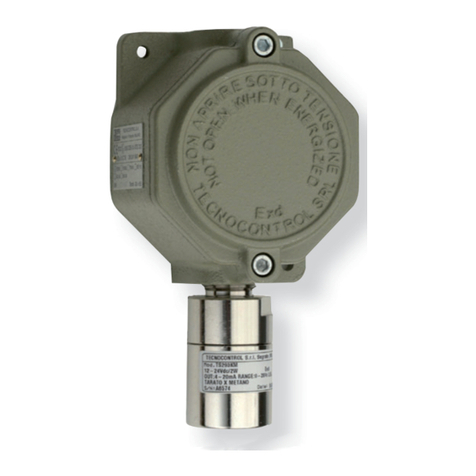
Tecnocontrol
Tecnocontrol SE138PX user manual
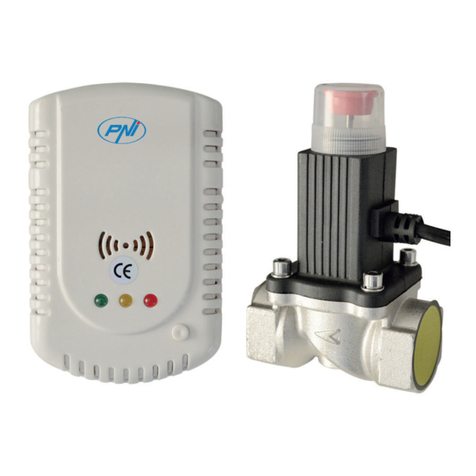
PNI
PNI GD-01 user manual

Domino
Domino GAS HOME Installation and operation manual
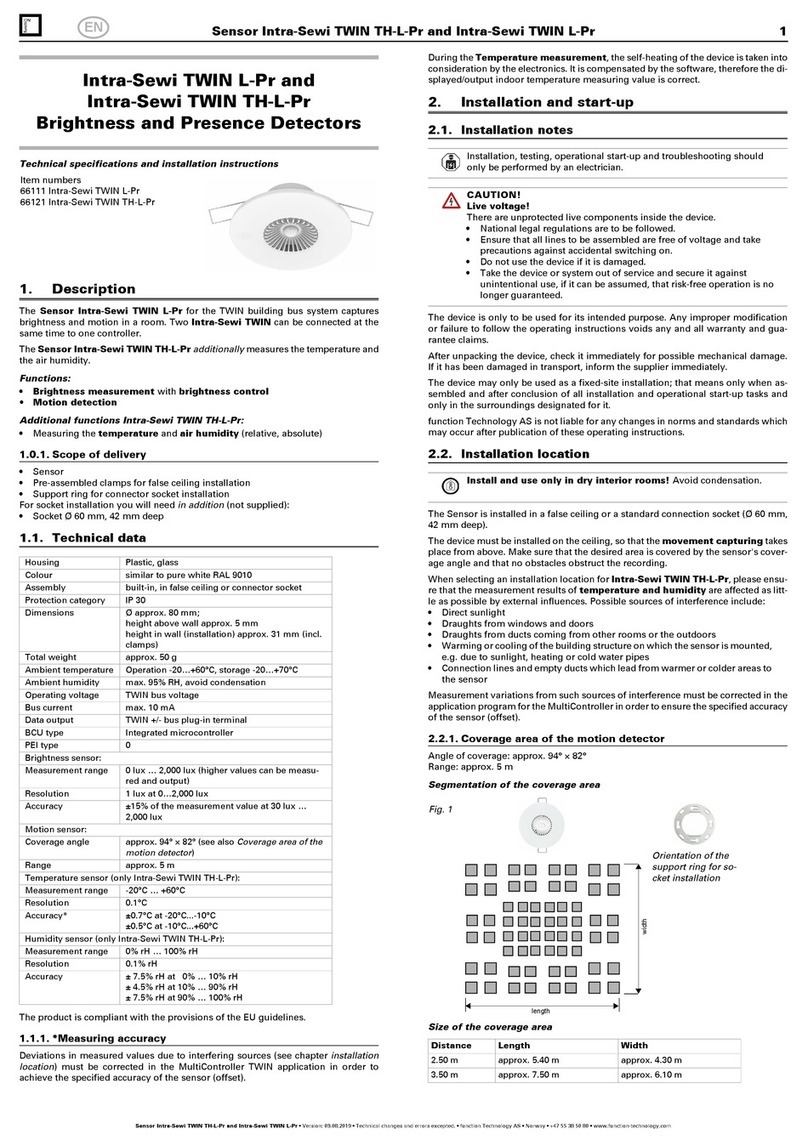
Elsner
Elsner Intra-Sewi TWIN L-Pr Installation and startup
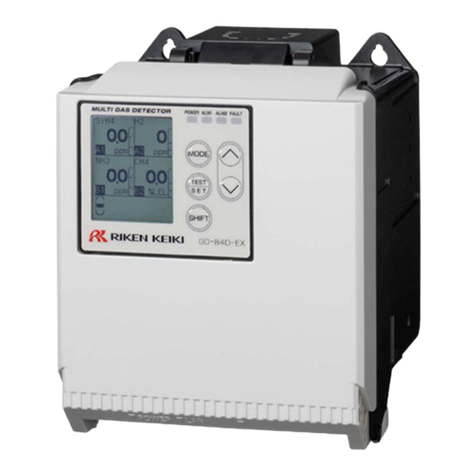
Riken Keiki
Riken Keiki GD-84D-EX Series operating manual
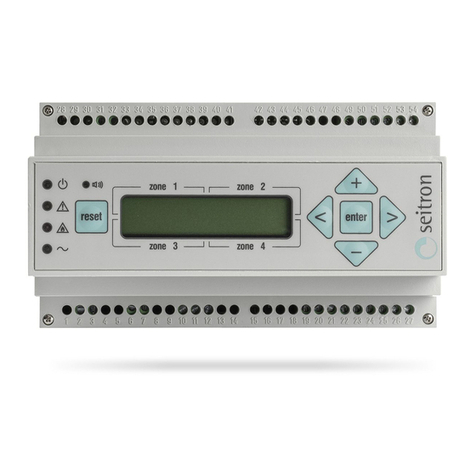
Seitron
Seitron RYM02M Series User Manual and Safety Instructions
